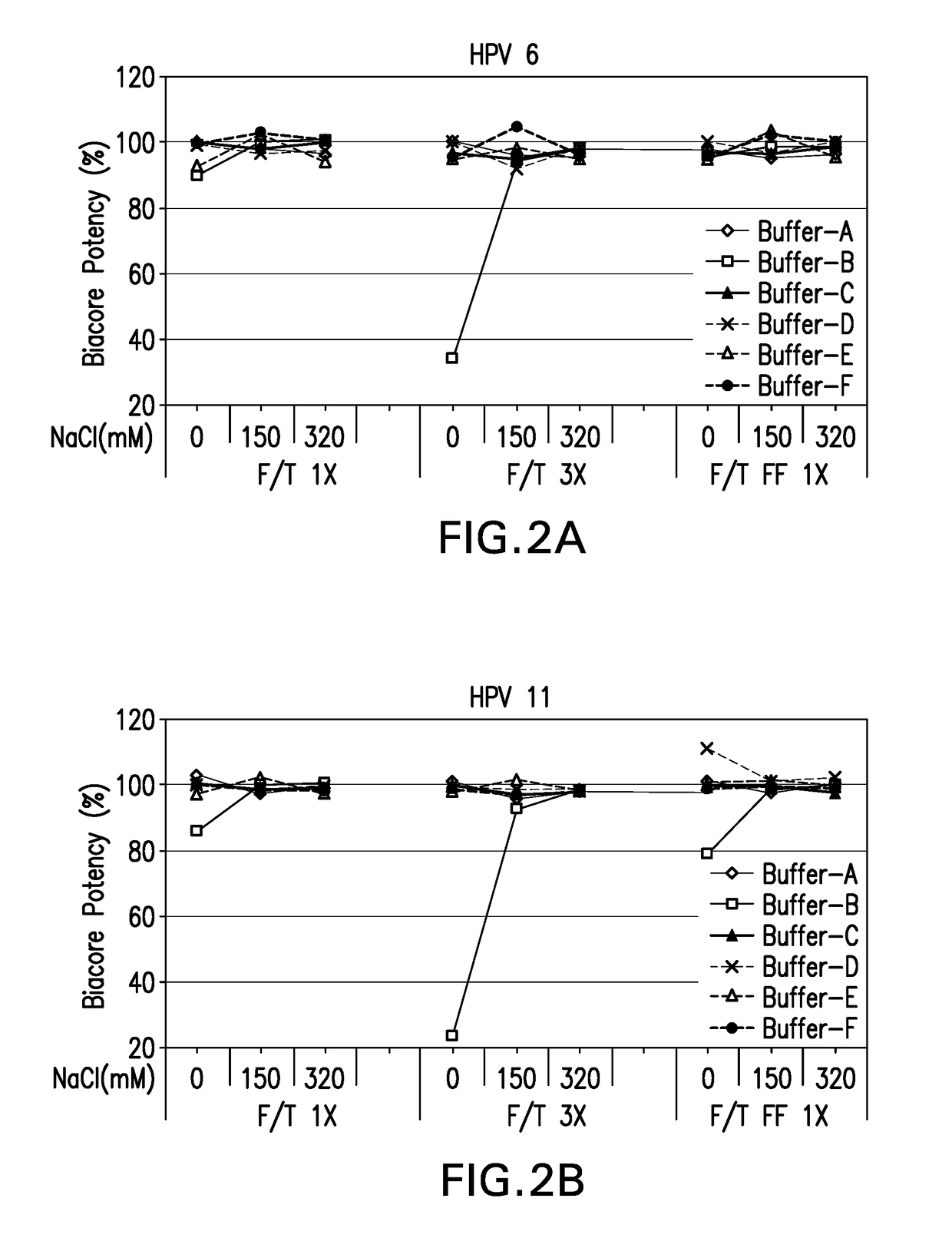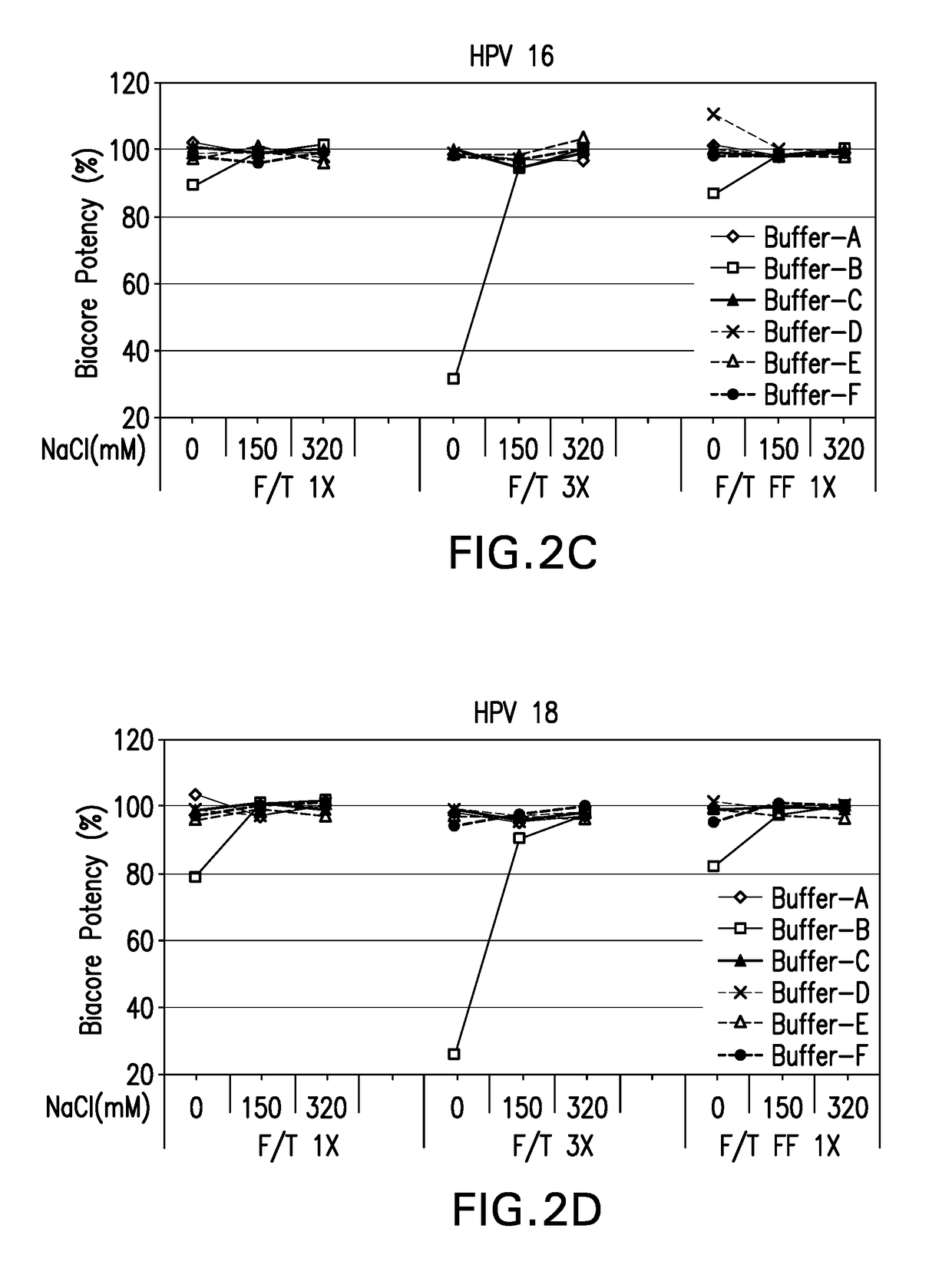HPV vaccine formulations comprising aluminum adjuvant and methods of producing same
a technology of adjuvant and aluminum, which is applied in the field of human papillomavirus (hpv) antigen formulations, can solve the problems of adjuvant particle agglomeration, loss of adjuvant activity, and physical damage, and achieve the effect of increasing antigen stability
- Summary
- Abstract
- Description
- Claims
- Application Information
AI Technical Summary
Benefits of technology
Problems solved by technology
Method used
Image
Examples
example 1
Materials and Methods.
[0092](a) Sample Preparation:
[0093]The Human Papillomavirus Quadrivalent (Types 6, 11, 16, 18) Vaccine, Recombinant, known as GARDASIL® (Merck and Co. Inc., Whitehouse Station, N.J.), was used as an exemplary vaccine in the studies described herein. GARDASIL® is a non-infectious recombinant, quadrivalent vaccine prepared from the highly purified virus-like particles (VLPs) of the major capsid (L1) protein of HPV types 6, 11, 16 and 18. GARDASIL® samples used in this study (referred to herein as “HPV 4-valent vaccine” or “HPV quadrivalent vaccine”) consisted of final container lots manufactured as described previously (Lowe, R. S. et al., J. Infect. Dis. 176: 1141-45 (1997); Cook, J. C. et al., Protein Expres Purif. 17: 477-84 (1999). Briefly, type-specific HPV L1 proteins were produced by separate fermentations in recombinant Sacharomyces cervisiae and self assembled into VLPs. The VLPs were purified by a series of chemical and physical methods. Each of the pur...
example 2
[0123]In-vitro antigenicity of 4-valent HPV vaccine formulations comprising HPV VLPs was evaluated using a neutralization antibody binding assay (Surface Plasmon Resonance, Biacore). The analysis for antigen bioactivity was determined using the Biacore 2000 and Biacore 3000 instruments (GE Healthcare Biosciences AB, Piscataway, N.J.). Biacore was performed for the 4-valent HPV vaccine test formulations that were either freeze-thawed or lyophilized. The lyophilized 4-valent HPV formulations were reconstituted with sterile water for injection as described in EXAMPLE 1 prior to aluminum dissolution. All test formulations comprised HPV type 6, 11, 16, and 18 VLPs suspended in buffers B-1 through B-18 diluted with dissolution buffer.
[0124]All 4 types of HPV VLP antigens in each 4-valent HPV vaccine formulation were assayed for in vitro antigenicity by Biacore analysis. The Biacore conditions utilized were as described in Mach et al. (J. Pharm. Sci. 95: 2195-2206 (200...
example 3
Osmolality Measurements.
[0128]Osmolality measurements were performed on all the control 4-valent HPV formulations in various buffers (B-1 through B-18) prior to either freeze thaw or lyophilization process. Results indicate that there is an increase in osmolality values with increase in salt concentration for all the buffers (FIG. 5). The contribution to the osmolality is mainly from the excipients (mannitol, sucrose, and glycine) and salt (sodium chloride) and not from the histidine, HPV antigens or MAA (as seen in the case of buffer B-2, which has the least osmolality). The osmolality for HPV 4-valent vaccine that was in formulation buffer B-14 (similar to the current Gardasil® formulation) was around 585 mOsm (FIG. 5). Buffers B-13 through B-18 (see Table 1), with the exception of buffer B-14 had excipients with high salt concentration that contributed to the higher tonicity for those formulations. In contrast, buffers B-1 through B-12, with the exception of buffers B-9 and B-10,...
PUM
| Property | Measurement | Unit |
|---|---|---|
| temperature | aaaaa | aaaaa |
| temperature | aaaaa | aaaaa |
| temperature | aaaaa | aaaaa |
Abstract
Description
Claims
Application Information
 Login to View More
Login to View More - R&D
- Intellectual Property
- Life Sciences
- Materials
- Tech Scout
- Unparalleled Data Quality
- Higher Quality Content
- 60% Fewer Hallucinations
Browse by: Latest US Patents, China's latest patents, Technical Efficacy Thesaurus, Application Domain, Technology Topic, Popular Technical Reports.
© 2025 PatSnap. All rights reserved.Legal|Privacy policy|Modern Slavery Act Transparency Statement|Sitemap|About US| Contact US: help@patsnap.com



